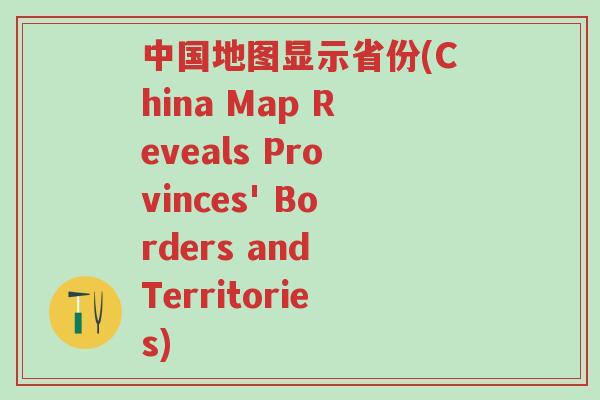Introduction
China is one of the biggest countries in the world, and it is also one of the most diverse countries in terms of culture, language, geography, and natural resources. One of the ways to understand China better is by looking at its provincial borders and territories, which reflect different historical, political, social, and economic realities. In this article, we will explore the geography and history of China's provinces, and how they relate to the nation's development and identity.

The Natural Landscape of China's Provinces
China has a vast and varied landscape, ranging from high mountains to deep valleys, from vast deserts to dense forests, from mighty rivers to vast plateaus. These natural features have greatly influenced the formation and boundaries of China's provinces. For instance, the Himalayas serve as a natural barrier between China and India, and the Yangtze River is not only the longest river in China but also divides the country into north and south regions. Therefore, most of the provinces in China have their unique geological, climatic, and environmental conditions that define their economic prospects and cultural traditions.
The Historical and Political Background of China's Provinces
The provincial borders and territories of China reflect a long and complex history of imperial, dynastic, and national rule. The earliest Chinese dynasties such as Shang and Zhou had their capitals in different regions of modern-day China, and they developed their administrative and military systems based on the geography and natural resources of their domains. As China became more unified under the Qin and Han dynasties, the concept of provinces or zhou emerged as a way to govern the vast empire effectively. Later, the Yuan, Ming, and Qing dynasties maintained this administrative structure, with some modifications such as changing the names and sizes of some provinces. In the early 20th century, after the fall of the Qing dynasty, China went through a period of fragmentation, civil strife, and foreign intervention. During this time, various warlords, factions, and colonial powers established their own territories and administrative units, which often overlapped with the traditional provinces. After the founding of the People's Republic of China in 1949, the new government reorganized the provinces and created new ones based on political and economic considerations, such as the promotion of minority autonomy, the rationalization of resources allocation, and the consolidation of power. Today, China has 23 provinces, five autonomous regions, four municipalities, and two special administrative regions.
The Sociocultural Diversity of China's Provinces
China is one of the most culturally diverse countries in the world, with more than 50 ethnic groups and hundreds of subcultures. The provincial borders and territories of China reflect some of this diversity, as certain provinces have a dominant ethnic group, language, religion, or tradition. For example, Xinjiang Autonomous Region is mainly inhabited by Uighur Muslims, and Tibet Autonomous Region is predominantly Tibetan Buddhist. Some provinces also have a distinct dialect or language, such as Guangdong Province, where Cantonese is spoken, or Sichuan Province, where Sichuanese or Sichuanhua is spoken. The diversity of China's provinces has also contributed to the richness and variety of its cuisine, arts, crafts, and festivals.
The Economic Development of China's Provinces
China has undergone tremendous economic development in the past few decades, and its provinces have played a critical role in this process. Some provinces are known for their natural resources, such as Inner Mongolia for its coal, Liaoning for its steel, and Hainan for its tropical fruits. Other provinces are known for their manufacturing industries, such as Guangdong for its electronics, Zhejiang for its garments, and Jiangsu for its machinery. Some provinces have also become major hubs of innovation, finance, and service, such as Beijing, Shanghai, and Guangzhou. However, the economic development of China's provinces is not evenly distributed, and there are still significant gaps between the coastal and inland regions, between the urban and rural areas, and between the rich and poor provinces. The Chinese government has implemented various policies and initiatives to reduce these disparities, such as the Belt and Road Initiative, the Western Development Strategy, and the Rural Revitalization Plan.
The National Identity of China's Provinces
China is not only a geographical entity but also a cultural, political, and psychological construct. The provincial borders and territories of China are not only administrative units but also symbolic representations of China's national identity and unity. The Chinese people have a strong attachment to their province or ancestral homeland, and they often use regional accents, customs, or food to express their identity. However, they also share a common language, script, history, and destiny that transcend their provincial boundaries. In this sense, China's provincial borders and territories are not only geographical but also cultural and political frontiers that connect and separate different groups of people, ideas, and interests. Understanding and appreciating these frontiers is crucial for understanding and appreciating the diversity and unity of China.
Conclusion
China's provincial borders and territories are not just lines on a map but also windows to its history, culture, geography, and economy. By studying China's provinces, we can appreciate the complexity and richness of its national identity and diversity. We can also learn how China's provinces interact with each other and with the rest of the world, and how this interaction shapes China's role and influence in the 21st century. Therefore, exploring China's provincial borders and territories is not only an academic exercise but also a cultural and political imperative for anyone who wants to understand China better.




